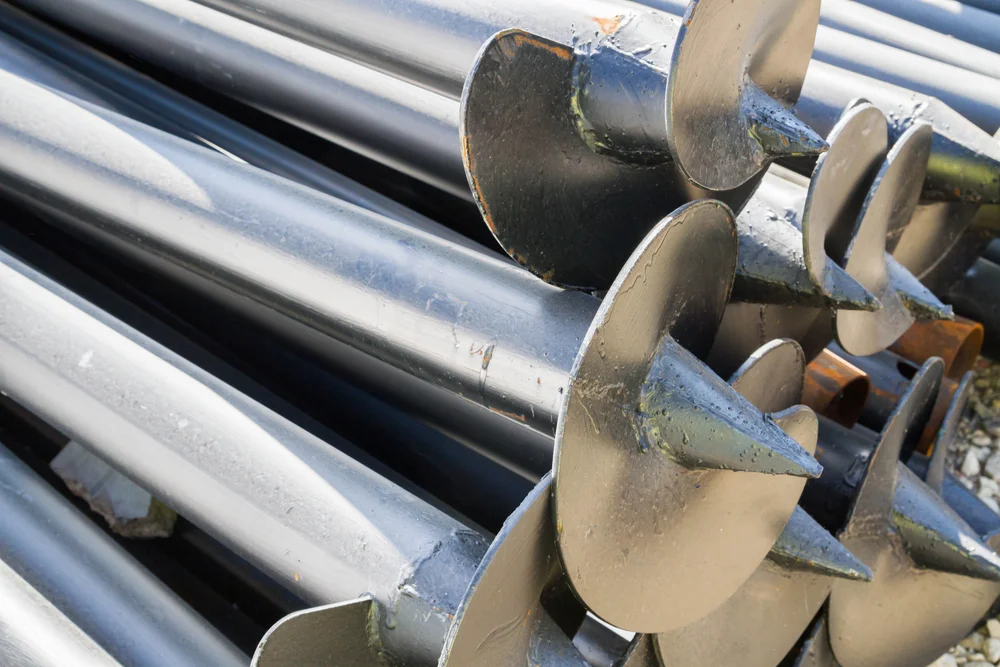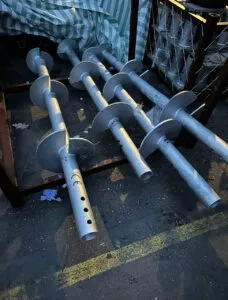
5 Reasons Choose Screw Piles are better than Concrete Underpinning.
What are Screw Piles?
When it comes to the construction and foundation of a building, there are a variety of different materials and methods that can be used to ensure a strong and solid base.
One of the preferred methods of foundation installation is using screw piles over concrete underpinning.
There are a variety of benefits to using this method.
- Faster installation
- Lower cost
- Less disruption to existing structures
- Easier access to limited spaces
- Greater load bearing capabilities.
So let’s see what the top ten reasons for using screw piles over concrete underpinning are.
Screw Piles Have a Faster Installation Process
Installation actively speeds up the process compared to traditional concrete underpinning, allowing you to complete the job in a fraction of the time!
Screw piles are easier to install as operators drive them into the ground with a hydraulic torque motor, rather than having to dig and pour like concrete.
This means the installation process actively moves much quicker and requires less labor. Screw piles can also fit into much tighter spaces, as they are much smaller than concrete piers.
This can be a major advantage in areas where access is limited.
Additionally, if adjustments are needed, operators can make them quickly without breaking and re-pouring concrete.
This makes screw piles an ideal choice for projects requiring a fast turnaround.
Lower Cost
For those looking to save on cost, screw pile underpinning actively provides a cost-effective alternative to traditional concrete underpinning.
Screw piles actively cut costs compared to concrete underpinning, as installers can drive them into the ground with much less labor and time.
This means the installation process for screw piles actively moves faster and more cost-effectively than concrete underpinning.
Additionally, screw piles’ durable steel or other materials actively resist damage over time, making them less likely to require expensive repairs or replacement in the future.
This can further reduce screw pile underpinning’s overall cost compared to concrete underpinning down the road.
Less Disruption to Existing Structures
You can actively reduce disruption to existing structures by using screw pile underpinning instead of concrete underpinning.
Screw pile underpinning actively causes less disruption than concrete underpinning because it requires fewer adjustments and modifications to existing foundation systems.
This makes screw piles easier to install and less likely to actively damage the existing foundation, walls, and floors. Since less disruption is needed, screw piles also actively shorten the overall installation time.
Additionally, because installers can pre-fabricate screw piles, they can actively install them quickly, saving time and money.
What’s more, screw piles are less likely to actively cause vibration or noise when being put in, so there is less disruption to nearby residents and businesses.
This makes the installation process more efficient, since it does not actively require special permits or costly noise-reduction techniques.
Furthermore, since the installation process moves faster, less manpower is actively required, reducing costs.
All of these factors make screw pile underpinning a more attractive option for those looking to actively avoid disrupting existing structures.
Easier to Access Limited Spaces
Using screw pile underpinning instead of concrete underpinning actively simplifies accessing limited spaces, so you can quickly complete the job with minimal disruption.
Screw piles’ compact size and ability to drive into tight spaces make them ideal for jobs where space is limited.
Installing screw piles also moves much faster than installing concrete underpinning, as they don’t require clearing and leveling a large area. Additionally, they don’t need a concrete truck, saving time and resources.
This makes screw piles the perfect choice for accessing limited spaces, as installers can put them in quickly with minimal disruption.
The screw pile installation process is also much simpler than concrete underpinning. It requires a much smaller excavation area and moves faster.
This means installers can complete the job in a fraction of the time concrete underpinning takes. Additionally, screw piles can go into areas with limited access, like narrow passages or confined spaces.
This makes screw piles ideal for jobs requiring access to limited or difficult to reach spaces, as installers can quickly put them in with minimal disruption.
Screw Piles Have Greater Load Bearing Capabilities
You’ll actively benefit from greater load-bearing capabilities when using screw piles instead of concrete underpinning.
Screw piles can actively provide greater load-bearing capabilities than concrete underpinning, as engineers design them to handle heavier weights.
This is especially true of screw piles with deeper foundations.
These deeper foundations actively spread the weight of the structure over a larger area, resulting in higher load-bearing capacity.
Additionally, installers can adjust screw piles to meet a structure’s specific load-bearing needs, while concrete underpinning remains fixed in place.
This gives the user the ability to actively customize screw piles’ load-bearing capabilities, which can be advantageous in certain situations.
In contrast, concrete underpinning generally sticks to a single load-bearing capacity.

Using Screw Piles Over Concrete Underpinning – Frequently Asked Questions
What type of soil is most suitable for screw piles and underpinning?
Screw pile underpinning actively provides an effective and efficient way to reinforce or strengthen foundations, particularly in soil less ideal for traditional concrete foundations.
The most suitable soils are cohesive and non-cohesive ones, such as silt and clay.
Loose, sandy soils, which tend to shift and settle, are less suitable. For screw pile underpinning to be most effective, the soil must actively support the structure’s weight.
Are screw piles suitable for use in areas with high water tables?
Screw piles are not typically suitable for use in areas with high water tables.
This is because the water table, the top of which is determined by the elevation of the water in the soil, can cause the piles to be unstable when they are placed too deep, as the piles must be driven into the ground to support the building.
Additionally, the high water table can cause corrosion of the piles over time, leading to a weakened and less secure foundation. Therefore, if a high water table is present, concrete underpinning is usually the more suitable option.
What is the maximum depth of a screw pile?
Screw piles can be installed to depths greater than those of conventional foundation methods.
The maximum depth varies depending on the size, type, and material of the pile. Generally, screw piles can be installed up to depths of 30 feet or more.
However, for more demanding applications, specialised screw pile technology can be used to drive piles up to depths of over 100 feet.
As such, screw piles are an ideal choice for deep foundation applications.
Does screw pile underpinning require specialist equipment?
It does not actively require specialist equipment, with installers typically driving it in with an easily operated hydraulic torque motor.
This makes screw pile underpinning a cost-effective and efficient solution compared to concrete underpinning, which needs a more expensive machine and more labor time.
The installation process also actively moves much simpler and faster than concrete underpinning, as it does not require digging and installing large foundations.
Furthermore, screw pile underpinning has much more flexibility than concrete underpinning, since operators can easily adjust and move it.
This makes screw piles an ideal choice for areas with limited access or difficult terrain.
How long does screw pile underpinning typically take?
Screw pile underpinning is a relatively quick and simple underpinning solution compared to other methods such as concrete underpinning.
The installation process typically takes one to two days, depending on the complexity of the job.
During the installation process, specialist equipment is used to ensure that the piles are installed correctly and securely.
Once the piles are in place, the rest of the project can proceed relatively quickly.
This makes screw pile underpinning an ideal choice for projects with tight deadlines that require secure foundations.
Using Screw Piles Over Concrete Underpinning – Conclusion
Screw piles actively provide several advantages over concrete underpinning.
Installers can put them in much faster, and access even the most limited spaces.
They also cost less, and actively support greater load bearing capabilities.
Furthermore, screw piles cause less disruption to existing structures, making them an ideal choice for many construction and renovation projects.
All in all, screw piles are a great option for anyone looking for a cost-effective, reliable underpinning solution.
Contact us to find out how we can help.